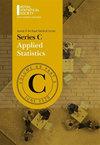关联图:在高维对应分析双图中可视化特定集群的关联
IF 1
4区 数学
Q3 STATISTICS & PROBABILITY
Journal of the Royal Statistical Society Series C-Applied Statistics
Pub Date : 2023-06-08
DOI:10.1093/jrsssc/qlad039
引用次数: 1
摘要
在分子生物学中,就像在许多其他科学领域一样,数据通常以矩阵或列联表的形式出现,其中包含一组变量(列)的许多观察结果(行)。虽然主成分分析或对应分析(CA)等投影方法可以用于获得此类数据的概览,但在矩阵非常大的情况下,将相关信息投影到二维或三维时可能会造成巨大的损失。然而,当这组变量可以分组到集群中时,这就为数据打开了一个新的角度。我们关注的问题是哪些观测值与一个集群相关联,并将其与其他集群区分开来。CA采用了一种几何学来回答这个问题。我们利用这一特征来引入关联图,以在复杂数据中可视化特定于集群的观察结果。无论数据矩阵维度如何,关联图都是二维的,描述了与一组变量相关的观测结果。我们在两个小数据集上演示了我们的方法,然后使用它来研究包含>10,000个样本的具有挑战性的基因组数据集。我们表明,关联图可以清楚地突出那些表征一组变量的观察结果。本文章由计算机程序翻译,如有差异,请以英文原文为准。
Association Plots: visualizing cluster-specific associations in high-dimensional correspondence analysis biplots
In molecular biology, just as in many other fields of science, data often come in the form of matrices or contingency tables with many observations (rows) for a set of variables (columns). While projection methods like principal component analysis or correspondence analysis (CA) can be applied for obtaining an overview of such data, in cases where the matrix is very large the associated loss of information upon projection into two or three dimensions may be dramatic. However, when the set of variables can be grouped into clusters, this opens up a new angle on the data. We focus on the question of which observations are associated to a cluster and distinguish it from other clusters. CA employs a geometry geared towards answering this question. We exploit this feature in order to introduce Association Plots for visualizing cluster-specific observations in complex data. Regardless of the data matrix dimensionality Association Plots are two-dimensional and depict the observations associated to a cluster of variables. We demonstrate our method on two small data sets and then use it to study a challenging genomic data set comprising >10,000 samples. We show that Association Plots can clearly highlight those observations which characterise a cluster of variables.
求助全文
通过发布文献求助,成功后即可免费获取论文全文。
去求助
来源期刊
CiteScore
2.50
自引率
0.00%
发文量
76
审稿时长
>12 weeks
期刊介绍:
The Journal of the Royal Statistical Society, Series C (Applied Statistics) is a journal of international repute for statisticians both inside and outside the academic world. The journal is concerned with papers which deal with novel solutions to real life statistical problems by adapting or developing methodology, or by demonstrating the proper application of new or existing statistical methods to them. At their heart therefore the papers in the journal are motivated by examples and statistical data of all kinds. The subject-matter covers the whole range of inter-disciplinary fields, e.g. applications in agriculture, genetics, industry, medicine and the physical sciences, and papers on design issues (e.g. in relation to experiments, surveys or observational studies).
A deep understanding of statistical methodology is not necessary to appreciate the content. Although papers describing developments in statistical computing driven by practical examples are within its scope, the journal is not concerned with simply numerical illustrations or simulation studies. The emphasis of Series C is on case-studies of statistical analyses in practice.

 求助内容:
求助内容: 应助结果提醒方式:
应助结果提醒方式:


